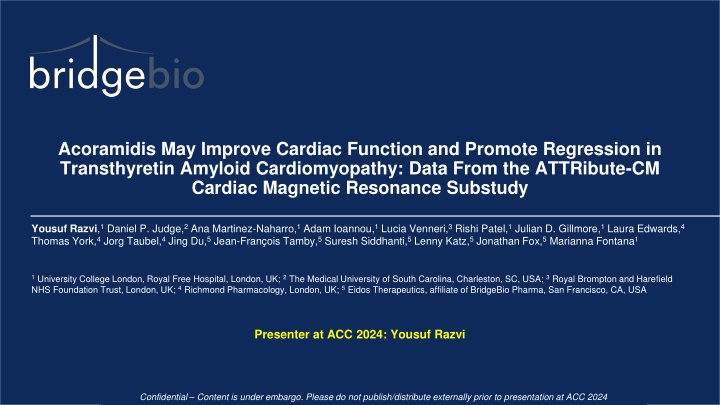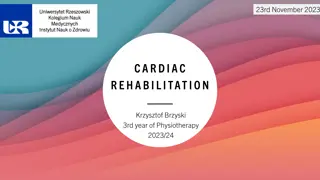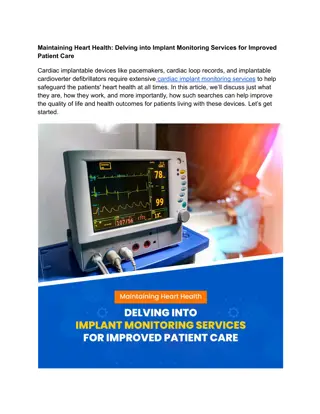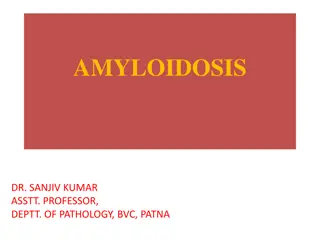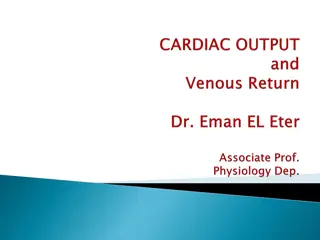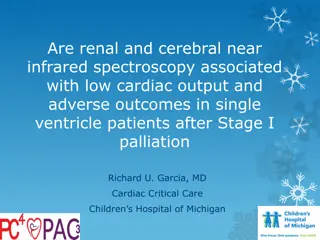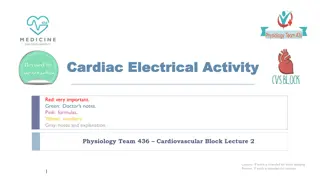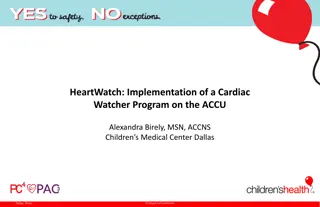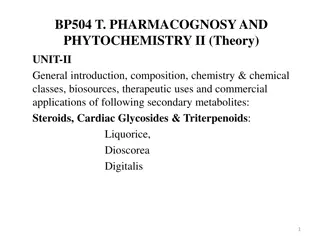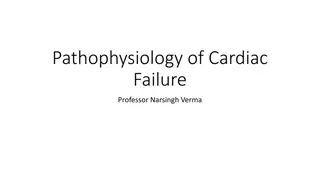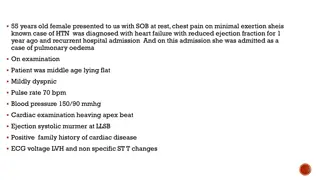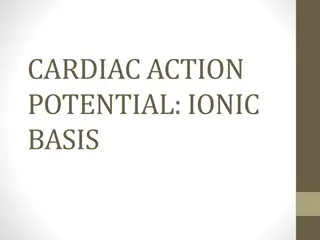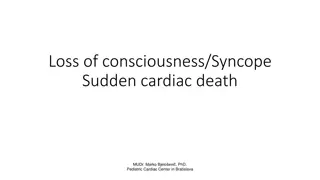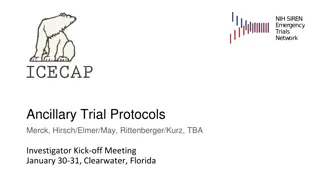Acoramidis Improves Cardiac Function in Transthyretin Amyloid Cardiomyopathy
Acoramidis, a next-generation TTR stabilizer, shows promising results in improving cardiac function and promoting regression in Transthyretin Amyloid Cardiomyopathy. The ATTRibute-CM Cardiac Magnetic Resonance Substudy evaluated changes in cardiac structure, function, and amyloid burden after treatment with acoramidis or placebo. Results indicate potential benefits in cardiac health for patients with this condition. The study involved participants enrolled in a clinical trial and utilized CMR imaging to track responses to treatment. Further research and clinical trials may be warranted to confirm these findings and explore the full potential of acoramidis in managing transthyretin amyloid cardiomyopathy.
Download Presentation

Please find below an Image/Link to download the presentation.
The content on the website is provided AS IS for your information and personal use only. It may not be sold, licensed, or shared on other websites without obtaining consent from the author.If you encounter any issues during the download, it is possible that the publisher has removed the file from their server.
You are allowed to download the files provided on this website for personal or commercial use, subject to the condition that they are used lawfully. All files are the property of their respective owners.
The content on the website is provided AS IS for your information and personal use only. It may not be sold, licensed, or shared on other websites without obtaining consent from the author.
E N D
Presentation Transcript
Acoramidis May Improve Cardiac Function and Promote Regression in Transthyretin Amyloid Cardiomyopathy: Data From the ATTRibute-CM Cardiac Magnetic Resonance Substudy Yousuf Razvi,1Daniel P. Judge,2Ana Martinez-Naharro,1Adam Ioannou,1Lucia Venneri,3Rishi Patel,1Julian D. Gillmore,1Laura Edwards,4 Thomas York,4Jorg Taubel,4Jing Du,5Jean-Fran ois Tamby,5Suresh Siddhanti,5Lenny Katz,5Jonathan Fox,5Marianna Fontana1 1University College London, Royal Free Hospital, London, UK; 2The Medical University of South Carolina, Charleston, SC, USA; 3Royal Brompton and Harefield NHS Foundation Trust, London, UK; 4Richmond Pharmacology, London, UK; 5Eidos Therapeutics, affiliate of BridgeBio Pharma, San Francisco, CA, USA Presenter at ACC 2024: Yousuf Razvi Confidential Content is under embargo. Please do not publish/distribute externally prior to presentation at ACC 2024 Confidential For Internal Use Only Not for distribution
Background ATTR-CM is caused by deposition of TTR amyloid fibrils in the myocardium, which can lead to progressive heart failure, significantly impaired quality of life, hospitalization, and premature death1-7 Acoramidis is a next-generation, oral, near-complete TTR stabilizer inhibits dissociation of tetrameric TTR into monomers that can form amyloid fibrils8 In ATTRibute-CM*, acoramidis met its primary hierarchical endpoint of mortality, cardiovascular-related hospitalization, change in NT-proBNP and 6MWD (P <0.0001)10 CMR with ECV mapping has proven utility in tracking response to treatment in cardiac amyloidosis by assessing changes in cardiac structure, function, and amyloid burden.11 Objective: The ATTRibute-CM CMR substudy was conducted to assess changes in cardiac structure, function, and cardiac amyloid burden after treatment with acoramidis or placebo. *ATTRibute-CM (NCT03860935) was a multi-center, double-blind, placebo-controlled, phase 3 ATTR-CM clinical trial to evaluate efficacy and safety of acoramidis. Patients were randomized 2:1 to receive 800mg acoramidis or matching placebo twice daily for 30 months. 6MWD, 6-minute walking distance; ATTR-CM, transthyretin amyloid cardiomyopathy; CMR, cardiac magnetic resonance; ECV, extracellular volume; NT-proBNP, N-terminal pro-B-type natriuretic peptide; TTR, transthyretin. 1. Liz MA, et al. Neurol Ther. 2020;9(2):395-402; 2. Vieira M, Saraiva MJ. Biomol Concepts. 2014;5(1):45-54; 3. Witteles RM, et al. JACC Heart Fail. 2019;7(8):709-716; 4. Rintell D, et al. Orphanet J Rare Dis. 2021;16(1):70; 5. Hanna M, et al. Am J Cardiol. 2021;141:98- 105; 6. Stewart M, et al. Neurol Ther. 2018;7(2):349-364; 7. Lauppe R, et al. ESC Heart Fail. 2022;9(3):2528-2537; 8. Fox JC, et al. Clin Pharmacol Drug Dev. 2020;9(1):115-129; 9. Ji A, et al. Presented at: 2020 International Symposium on Amyloidosis; September 14- 18, 2020; 10. Gillmore JD, et al. N Engl J Med. 2024;390(2):132-142; 11. Fontana F, et al. JACC Cardiovasc Imaging. 2021; 14 (1): 189-199.
Methods Participants were invited to enroll in the CMR substudy. All participants provided written informed consent. Initial CMR was performed at baseline before the first dose in 35 participants or within 3 months after the first dose in 17 participants (range, 14-105 days); subsequent CMR was performed at months 12, 24, and 30. All CMR images were read centrally at the National Amyloidosis Centre (London) and was performed blinded to other clinical data. ECV values were measured by drawing a region of interest in the basal-mid septum on four-chamber maps. Amyloid regression was defined as an absolute reduction in ECV >5%, progression as an absolute increase in ECV >5%, and ECV changes <5% were considered stable.1 Fifty-two participants enrolled in CMR substudy (acoramidis: n = 41; placebo: n = 11). Twenty-six of 41 participants receiving acoramidis and 5 of 11 receiving placebo completed month 30 scans. Two of 26 and 1 of 5 participants in the acoramidis and placebo groups, respectively, did not undergo ECV mapping at month 30 because of exclusionary renal impairment. 99mTc, technetium-99m; ATTR, transthyretin amyloid; BID, twice a day; CMR, cardiac magnetic resonance; ECV, extracellular volume; LVEF, left ventricular ejection fraction; LVGLS, left ventricular global longitudinal strain; LVMi, left ventricular mass index; LVSVi, left ventricular stroke volume index; RVEF, right ventricular ejection fraction, RVSVi, right ventricular stroke volume index 1. Martinez-Naharro A et al. Eur Heart J. 2022;43(45):4722-4735 3
Baseline Characteristics and CMR Parameters were Comparable Characteristic Acoramidis (n = 41) Placebo (n = 11) Age (years), median (range) 76 (57 86) 75 (55 84) Male sex, n (%) 37 (90.2) 10 (90.9) wt-ATTR-CM, n (%) 35 (85.4) 9 (81.8) V122I 5 (83.3) 1 (50.0) vATTR-CM, n (%) T60A 1 (16.7) 1 (50.0) 4 (9.8) 2 (18.2) Black 36 (87.8) 9 (81.8) Race, n (%) White 1 (2.4) 0 (0) Multiple races Years since diagnosis, mean (SD) 1.7 (1.3) 119.4 (21.9) 38.6 (11.3) 50.7 (12.3) -10.1 (2.4) 38.4 (10.8) 47.6 (12.8) 61.5 (8.1) 2.3 (1.8) 116.5 (29.5) 37.8 (10.3) 50.5 (12.0) -9.9 (2.5) 37.5 (10.3) 47.7 (9.0) 63.8 (7.9) LVMi, g/m2 LVSVi, mL/m2 LVEF, % LVGLS, % RVSVi, mL/m2 RVEF, % ECV, % Initial CMR parameters, mean (SD) BID, twice daily; CMR, cardiac magnetic resonance; ECV, extracellular volume; LVEF, left ventricular ejection fraction; LVGLS, left ventricular global longitudinal strain; LVMi, left ventricular mass index; LVSVi, left ventricular stroke volume index; RVEF, right ventricular ejection fraction. 4
Acoramidis Was Associated With a Trend Toward Reduced ECV From BL to Month 30 Compared With Placebo BL Month 12 Month 24 Month 30 68% 71% 74% 78% ECV : Placebo ECV reduction of 5% has been shown to indicate cardiac amyloid regression2and occurred in 3/26 (12%) patients receiving acoramidis and none receiving placebo at Month 30 Sustained amyloid progression 65% 66% 64% 58% ECV : Acoramidis Stability Late amyloid regression Note: Three participants (2/26 acoramidis, 1/5 placebo) did not undergo ECV mapping at M30 due to exclusionary renal impairment. 5 BL, baseline; ECV, extracellular volume
Consistent Improvement in CMR Parameters Was Observed With Acoramidis vs Placebo From Baseline to Month 30 6 ECV, extracellular volume; LVEF, left ventricular ejection fraction; LVGLS, left ventricular global longitudinal strain; LVMi, left ventricular mass index; LVSVi, left ventricular stroke volume index; RVEF, right ventricular ejection fraction.
Limitations Study was limited by small sample size. The three participants without ECV mapping may have led to an underestimation in ECV differences. Serial data were only available from participants with follow-up imaging visits, potentially adding a survival bias. All-cause mortality was higher in the placebo group (4/11; 36%) than in the acoramidis group (5/41; 12%) The extent of improvement observed in acoramidis recipients relative to placebo may have been underestimated Higher proportion of non-surviving placebo participants may have exhibited accelerated amyloid accumulation with associated deterioration in myocardial function had they survived longer. 7
Conclusion This is the first longitudinal CMR evaluation included within a phase 3 ATTR-CM clinical trial. Treatment with acoramidis was associated with cardiac amyloid regression in some participants and a trend toward cardiac structural and functional improvement compared with placebo. TTR stabilization with acoramidis may allow the rate of innate amyloid clearance mechanisms to exceed the rate of amyloid formation, thereby enabling cardiac remodelling and functional recovery. 8
